Taxation Law of Australia Individual Assignment LAWS20060, Term 1 2019
VerifiedAdded on 2023/01/17
|11
|3405
|69
Homework Assignment
AI Summary
This assignment solution addresses various aspects of Australian taxation law, covering key concepts such as income tax, capital gains tax (CGT), and fringe benefits tax (FBT). It analyzes scenarios involving deductions for business expenses, including interest expenses, mobile expenses, and childcare...
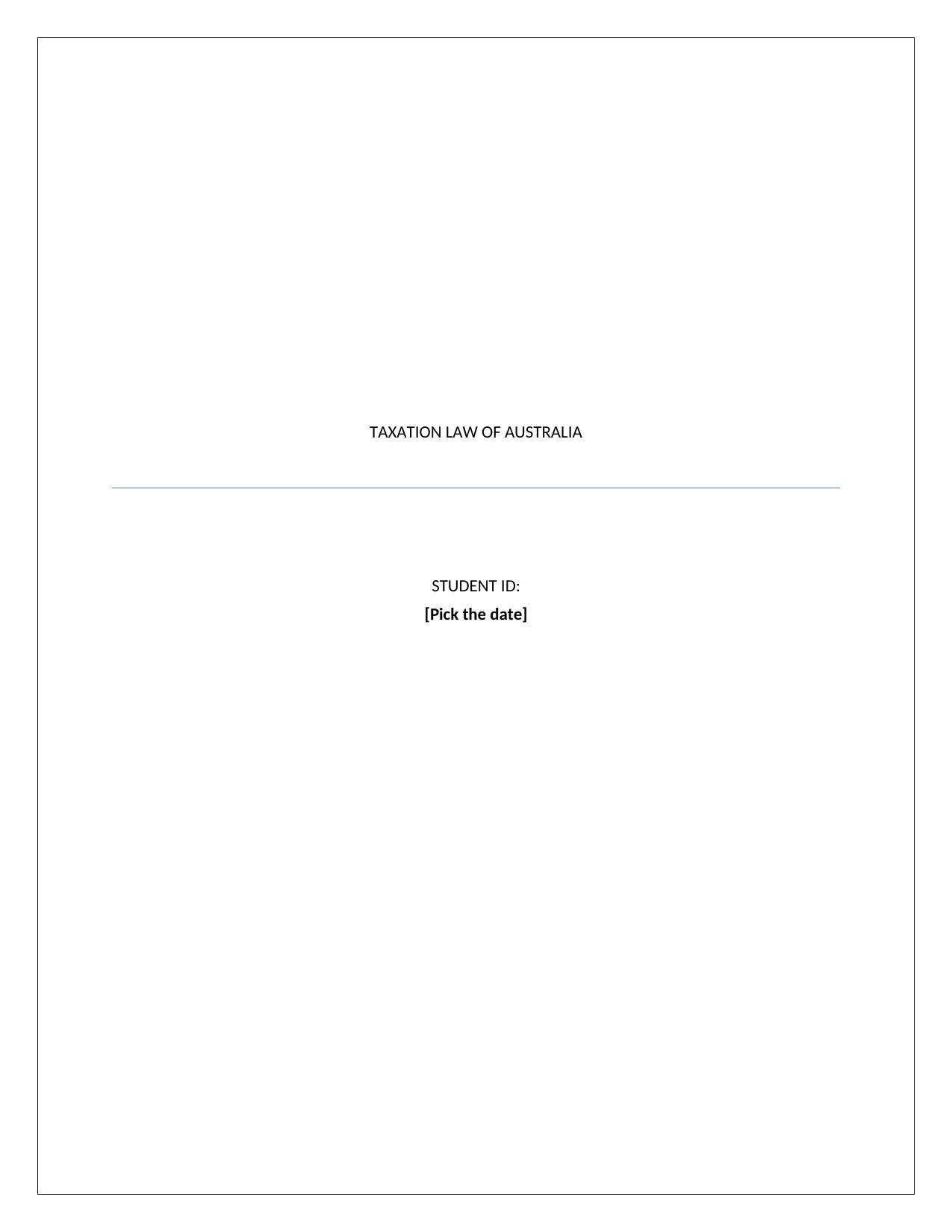
TAXATION LAW OF AUSTRALIA
STUDENT ID:
[Pick the date]
STUDENT ID:
[Pick the date]
Paraphrase This Document
Need a fresh take? Get an instant paraphrase of this document with our AI Paraphraser

Question 1
a) TR 2018/4 deals with the topic of effective life of depreciating assets for income tax
purposes1.
b) Division 17 of ITAA 1997 details the available tax offsets.
c) The highest marginal tax rate applicable for personal income tax is 45%.
d) Car is an asset which is exempt from the purview of CGT in Australia as has been indicated
in s. 118-5 ITAA 19972.
e) CGT event B1 tends to deal with using and enjoyment of asset without the possession of title.
f) The given formula is used for computation of income tax liability. As per the formula, to
compute the income tax liability the taxable income is multiplied by the applicable tax rate.
However, from this amount, any available tax offsets are subtracted so that the net tax
liability of the concerned reporting entity may be determined.
g) The given case involved a customs officer who had used legal services with regards to
defending his position against certain charges against him by his employer. The Tax
Commisioner disallowed a host of these expenses as being non=deductible under s. 8-1
ITAA 1997. However, the High Court finally decided that the legal expenses which the
customs officer incurred in defending himself were deductible under s. 8-1 ITAA 1997.
While reaching this verdict, the honorable court highlighted the following two aspects.
The expenses should be related to the production of assessable income which was tru
for the custom officer since he had to defend himself against formal charges with
regards to his conduct.
Also, the expenses should not be of private nature which was also satisfied with
regards to the custom officer.
h) There is a significant difference between the marginal tax and average tax since the former
refers to the tax rate that is applicable to any additional taxable income unlike the latter
which provides an average value which would be applicable to the complete income. In order
1 ATO, Taxable Ruling TR 2018/4, https://www.ato.gov.au/law/view/document?DocID=TXR%2FTR20184%2FNAT%2FATO
%2F00001
2 ATO, Income Tax Assessment Act 1997 – SECT 118.5, http://classic.austlii.edu.au/au/legis/cth/consol_act/itaa1997240/
s118.5.html
a) TR 2018/4 deals with the topic of effective life of depreciating assets for income tax
purposes1.
b) Division 17 of ITAA 1997 details the available tax offsets.
c) The highest marginal tax rate applicable for personal income tax is 45%.
d) Car is an asset which is exempt from the purview of CGT in Australia as has been indicated
in s. 118-5 ITAA 19972.
e) CGT event B1 tends to deal with using and enjoyment of asset without the possession of title.
f) The given formula is used for computation of income tax liability. As per the formula, to
compute the income tax liability the taxable income is multiplied by the applicable tax rate.
However, from this amount, any available tax offsets are subtracted so that the net tax
liability of the concerned reporting entity may be determined.
g) The given case involved a customs officer who had used legal services with regards to
defending his position against certain charges against him by his employer. The Tax
Commisioner disallowed a host of these expenses as being non=deductible under s. 8-1
ITAA 1997. However, the High Court finally decided that the legal expenses which the
customs officer incurred in defending himself were deductible under s. 8-1 ITAA 1997.
While reaching this verdict, the honorable court highlighted the following two aspects.
The expenses should be related to the production of assessable income which was tru
for the custom officer since he had to defend himself against formal charges with
regards to his conduct.
Also, the expenses should not be of private nature which was also satisfied with
regards to the custom officer.
h) There is a significant difference between the marginal tax and average tax since the former
refers to the tax rate that is applicable to any additional taxable income unlike the latter
which provides an average value which would be applicable to the complete income. In order
1 ATO, Taxable Ruling TR 2018/4, https://www.ato.gov.au/law/view/document?DocID=TXR%2FTR20184%2FNAT%2FATO
%2F00001
2 ATO, Income Tax Assessment Act 1997 – SECT 118.5, http://classic.austlii.edu.au/au/legis/cth/consol_act/itaa1997240/
s118.5.html
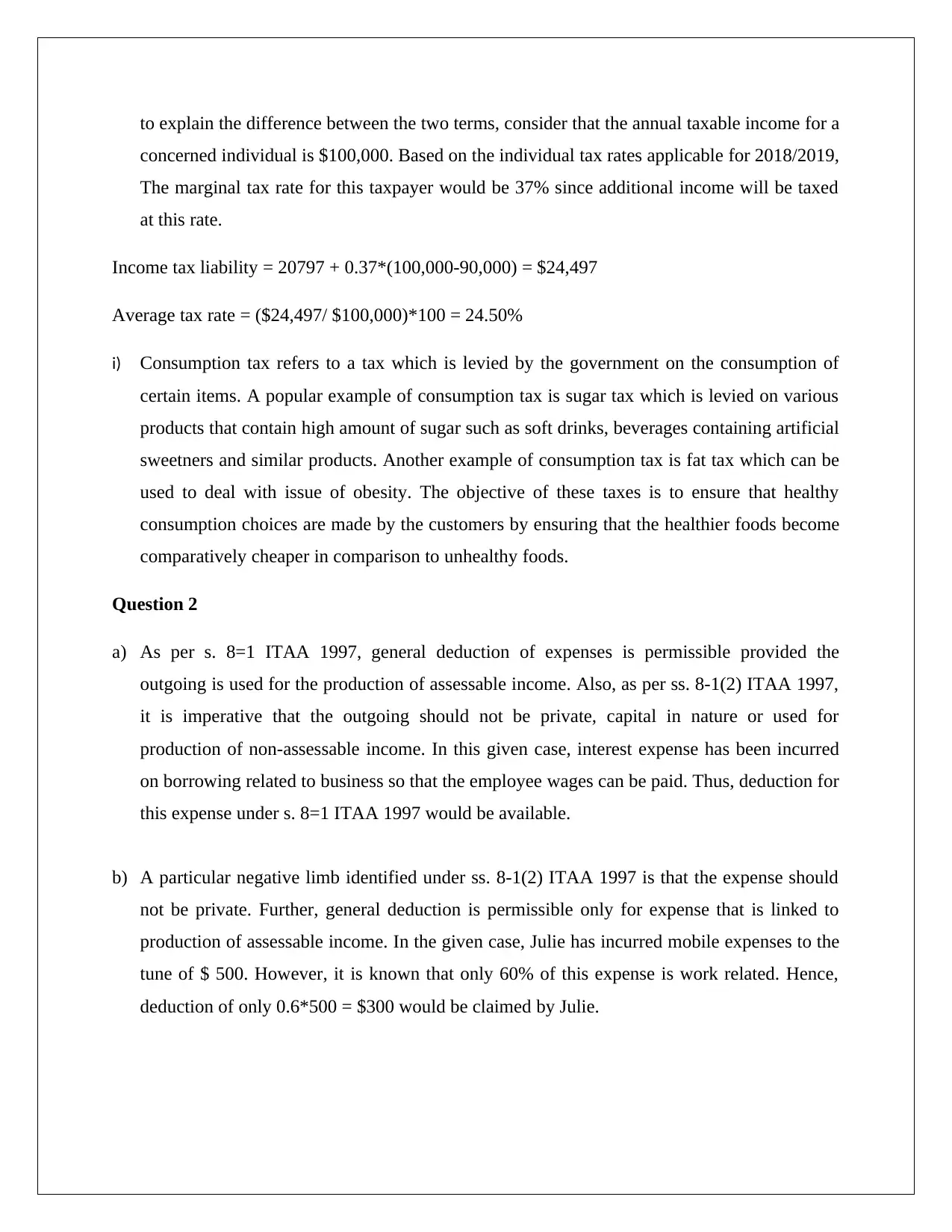
to explain the difference between the two terms, consider that the annual taxable income for a
concerned individual is $100,000. Based on the individual tax rates applicable for 2018/2019,
The marginal tax rate for this taxpayer would be 37% since additional income will be taxed
at this rate.
Income tax liability = 20797 + 0.37*(100,000-90,000) = $24,497
Average tax rate = ($24,497/ $100,000)*100 = 24.50%
i) Consumption tax refers to a tax which is levied by the government on the consumption of
certain items. A popular example of consumption tax is sugar tax which is levied on various
products that contain high amount of sugar such as soft drinks, beverages containing artificial
sweetners and similar products. Another example of consumption tax is fat tax which can be
used to deal with issue of obesity. The objective of these taxes is to ensure that healthy
consumption choices are made by the customers by ensuring that the healthier foods become
comparatively cheaper in comparison to unhealthy foods.
Question 2
a) As per s. 8=1 ITAA 1997, general deduction of expenses is permissible provided the
outgoing is used for the production of assessable income. Also, as per ss. 8-1(2) ITAA 1997,
it is imperative that the outgoing should not be private, capital in nature or used for
production of non-assessable income. In this given case, interest expense has been incurred
on borrowing related to business so that the employee wages can be paid. Thus, deduction for
this expense under s. 8=1 ITAA 1997 would be available.
b) A particular negative limb identified under ss. 8-1(2) ITAA 1997 is that the expense should
not be private. Further, general deduction is permissible only for expense that is linked to
production of assessable income. In the given case, Julie has incurred mobile expenses to the
tune of $ 500. However, it is known that only 60% of this expense is work related. Hence,
deduction of only 0.6*500 = $300 would be claimed by Julie.
concerned individual is $100,000. Based on the individual tax rates applicable for 2018/2019,
The marginal tax rate for this taxpayer would be 37% since additional income will be taxed
at this rate.
Income tax liability = 20797 + 0.37*(100,000-90,000) = $24,497
Average tax rate = ($24,497/ $100,000)*100 = 24.50%
i) Consumption tax refers to a tax which is levied by the government on the consumption of
certain items. A popular example of consumption tax is sugar tax which is levied on various
products that contain high amount of sugar such as soft drinks, beverages containing artificial
sweetners and similar products. Another example of consumption tax is fat tax which can be
used to deal with issue of obesity. The objective of these taxes is to ensure that healthy
consumption choices are made by the customers by ensuring that the healthier foods become
comparatively cheaper in comparison to unhealthy foods.
Question 2
a) As per s. 8=1 ITAA 1997, general deduction of expenses is permissible provided the
outgoing is used for the production of assessable income. Also, as per ss. 8-1(2) ITAA 1997,
it is imperative that the outgoing should not be private, capital in nature or used for
production of non-assessable income. In this given case, interest expense has been incurred
on borrowing related to business so that the employee wages can be paid. Thus, deduction for
this expense under s. 8=1 ITAA 1997 would be available.
b) A particular negative limb identified under ss. 8-1(2) ITAA 1997 is that the expense should
not be private. Further, general deduction is permissible only for expense that is linked to
production of assessable income. In the given case, Julie has incurred mobile expenses to the
tune of $ 500. However, it is known that only 60% of this expense is work related. Hence,
deduction of only 0.6*500 = $300 would be claimed by Julie.
⊘ This is a preview!⊘
Do you want full access?
Subscribe today to unlock all pages.

Trusted by 1+ million students worldwide
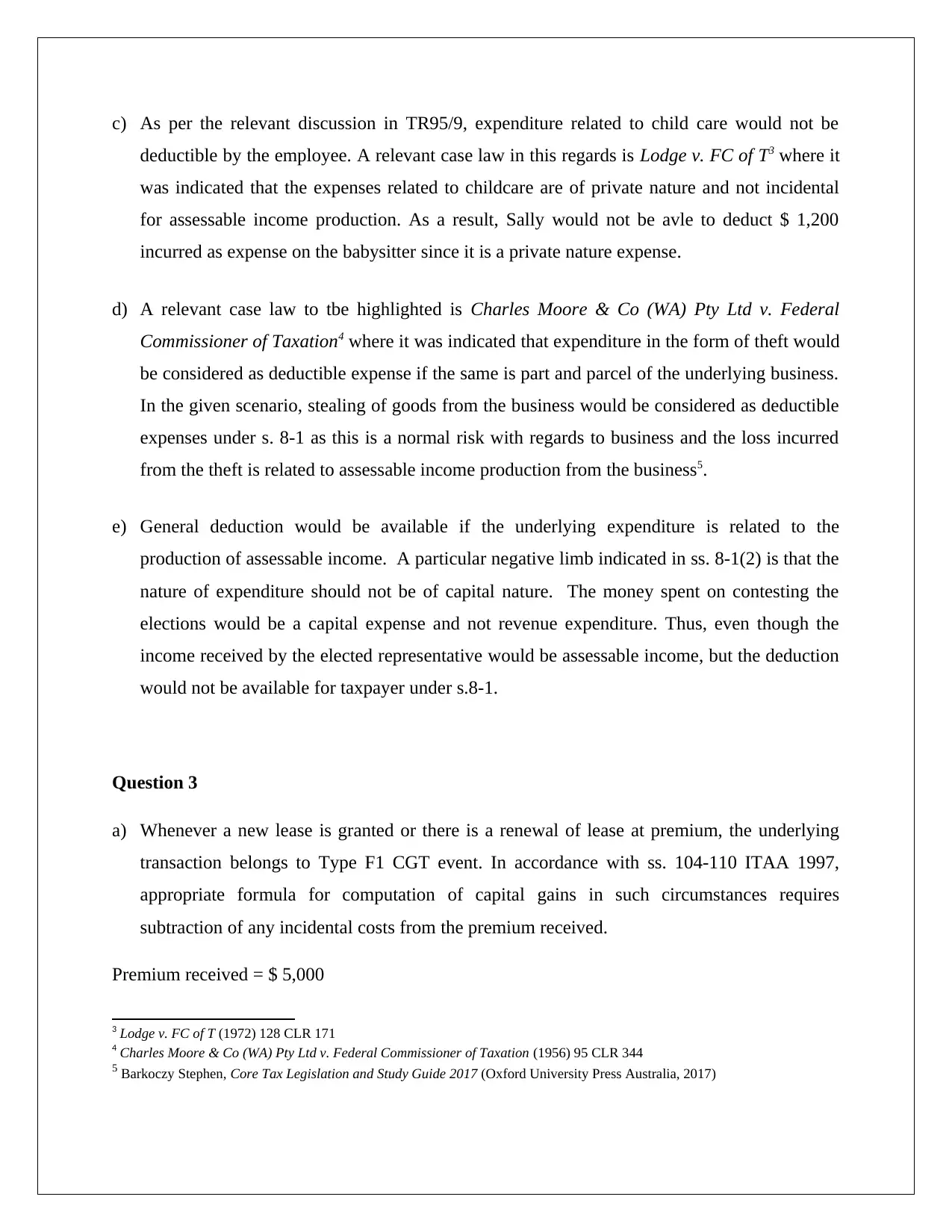
c) As per the relevant discussion in TR95/9, expenditure related to child care would not be
deductible by the employee. A relevant case law in this regards is Lodge v. FC of T3 where it
was indicated that the expenses related to childcare are of private nature and not incidental
for assessable income production. As a result, Sally would not be avle to deduct $ 1,200
incurred as expense on the babysitter since it is a private nature expense.
d) A relevant case law to tbe highlighted is Charles Moore & Co (WA) Pty Ltd v. Federal
Commissioner of Taxation4 where it was indicated that expenditure in the form of theft would
be considered as deductible expense if the same is part and parcel of the underlying business.
In the given scenario, stealing of goods from the business would be considered as deductible
expenses under s. 8-1 as this is a normal risk with regards to business and the loss incurred
from the theft is related to assessable income production from the business5.
e) General deduction would be available if the underlying expenditure is related to the
production of assessable income. A particular negative limb indicated in ss. 8-1(2) is that the
nature of expenditure should not be of capital nature. The money spent on contesting the
elections would be a capital expense and not revenue expenditure. Thus, even though the
income received by the elected representative would be assessable income, but the deduction
would not be available for taxpayer under s.8-1.
Question 3
a) Whenever a new lease is granted or there is a renewal of lease at premium, the underlying
transaction belongs to Type F1 CGT event. In accordance with ss. 104-110 ITAA 1997,
appropriate formula for computation of capital gains in such circumstances requires
subtraction of any incidental costs from the premium received.
Premium received = $ 5,000
3 Lodge v. FC of T (1972) 128 CLR 171
4 Charles Moore & Co (WA) Pty Ltd v. Federal Commissioner of Taxation (1956) 95 CLR 344
5 Barkoczy Stephen, Core Tax Legislation and Study Guide 2017 (Oxford University Press Australia, 2017)
deductible by the employee. A relevant case law in this regards is Lodge v. FC of T3 where it
was indicated that the expenses related to childcare are of private nature and not incidental
for assessable income production. As a result, Sally would not be avle to deduct $ 1,200
incurred as expense on the babysitter since it is a private nature expense.
d) A relevant case law to tbe highlighted is Charles Moore & Co (WA) Pty Ltd v. Federal
Commissioner of Taxation4 where it was indicated that expenditure in the form of theft would
be considered as deductible expense if the same is part and parcel of the underlying business.
In the given scenario, stealing of goods from the business would be considered as deductible
expenses under s. 8-1 as this is a normal risk with regards to business and the loss incurred
from the theft is related to assessable income production from the business5.
e) General deduction would be available if the underlying expenditure is related to the
production of assessable income. A particular negative limb indicated in ss. 8-1(2) is that the
nature of expenditure should not be of capital nature. The money spent on contesting the
elections would be a capital expense and not revenue expenditure. Thus, even though the
income received by the elected representative would be assessable income, but the deduction
would not be available for taxpayer under s.8-1.
Question 3
a) Whenever a new lease is granted or there is a renewal of lease at premium, the underlying
transaction belongs to Type F1 CGT event. In accordance with ss. 104-110 ITAA 1997,
appropriate formula for computation of capital gains in such circumstances requires
subtraction of any incidental costs from the premium received.
Premium received = $ 5,000
3 Lodge v. FC of T (1972) 128 CLR 171
4 Charles Moore & Co (WA) Pty Ltd v. Federal Commissioner of Taxation (1956) 95 CLR 344
5 Barkoczy Stephen, Core Tax Legislation and Study Guide 2017 (Oxford University Press Australia, 2017)
Paraphrase This Document
Need a fresh take? Get an instant paraphrase of this document with our AI Paraphraser
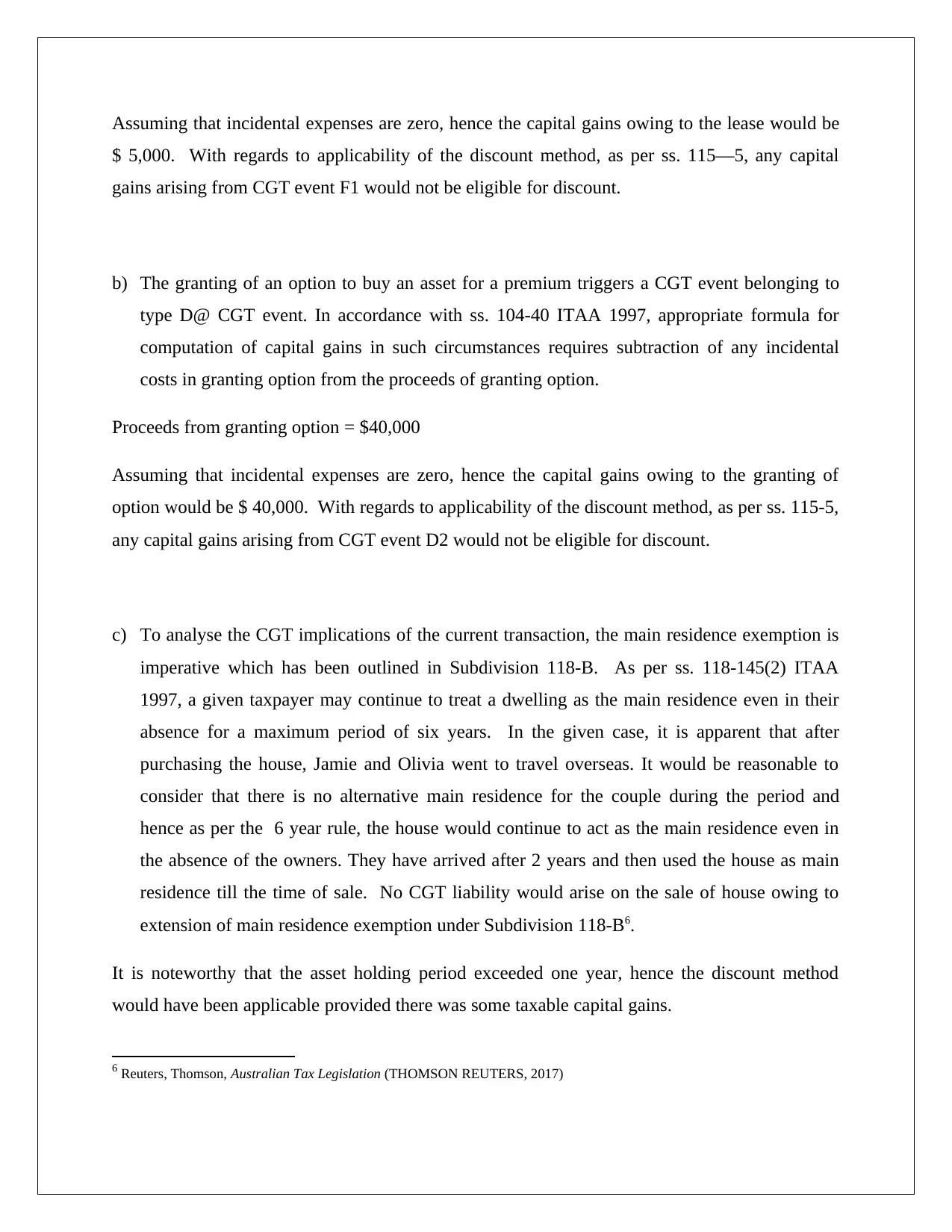
Assuming that incidental expenses are zero, hence the capital gains owing to the lease would be
$ 5,000. With regards to applicability of the discount method, as per ss. 115—5, any capital
gains arising from CGT event F1 would not be eligible for discount.
b) The granting of an option to buy an asset for a premium triggers a CGT event belonging to
type D@ CGT event. In accordance with ss. 104-40 ITAA 1997, appropriate formula for
computation of capital gains in such circumstances requires subtraction of any incidental
costs in granting option from the proceeds of granting option.
Proceeds from granting option = $40,000
Assuming that incidental expenses are zero, hence the capital gains owing to the granting of
option would be $ 40,000. With regards to applicability of the discount method, as per ss. 115-5,
any capital gains arising from CGT event D2 would not be eligible for discount.
c) To analyse the CGT implications of the current transaction, the main residence exemption is
imperative which has been outlined in Subdivision 118-B. As per ss. 118-145(2) ITAA
1997, a given taxpayer may continue to treat a dwelling as the main residence even in their
absence for a maximum period of six years. In the given case, it is apparent that after
purchasing the house, Jamie and Olivia went to travel overseas. It would be reasonable to
consider that there is no alternative main residence for the couple during the period and
hence as per the 6 year rule, the house would continue to act as the main residence even in
the absence of the owners. They have arrived after 2 years and then used the house as main
residence till the time of sale. No CGT liability would arise on the sale of house owing to
extension of main residence exemption under Subdivision 118-B6.
It is noteworthy that the asset holding period exceeded one year, hence the discount method
would have been applicable provided there was some taxable capital gains.
6 Reuters, Thomson, Australian Tax Legislation (THOMSON REUTERS, 2017)
$ 5,000. With regards to applicability of the discount method, as per ss. 115—5, any capital
gains arising from CGT event F1 would not be eligible for discount.
b) The granting of an option to buy an asset for a premium triggers a CGT event belonging to
type D@ CGT event. In accordance with ss. 104-40 ITAA 1997, appropriate formula for
computation of capital gains in such circumstances requires subtraction of any incidental
costs in granting option from the proceeds of granting option.
Proceeds from granting option = $40,000
Assuming that incidental expenses are zero, hence the capital gains owing to the granting of
option would be $ 40,000. With regards to applicability of the discount method, as per ss. 115-5,
any capital gains arising from CGT event D2 would not be eligible for discount.
c) To analyse the CGT implications of the current transaction, the main residence exemption is
imperative which has been outlined in Subdivision 118-B. As per ss. 118-145(2) ITAA
1997, a given taxpayer may continue to treat a dwelling as the main residence even in their
absence for a maximum period of six years. In the given case, it is apparent that after
purchasing the house, Jamie and Olivia went to travel overseas. It would be reasonable to
consider that there is no alternative main residence for the couple during the period and
hence as per the 6 year rule, the house would continue to act as the main residence even in
the absence of the owners. They have arrived after 2 years and then used the house as main
residence till the time of sale. No CGT liability would arise on the sale of house owing to
extension of main residence exemption under Subdivision 118-B6.
It is noteworthy that the asset holding period exceeded one year, hence the discount method
would have been applicable provided there was some taxable capital gains.
6 Reuters, Thomson, Australian Tax Legislation (THOMSON REUTERS, 2017)
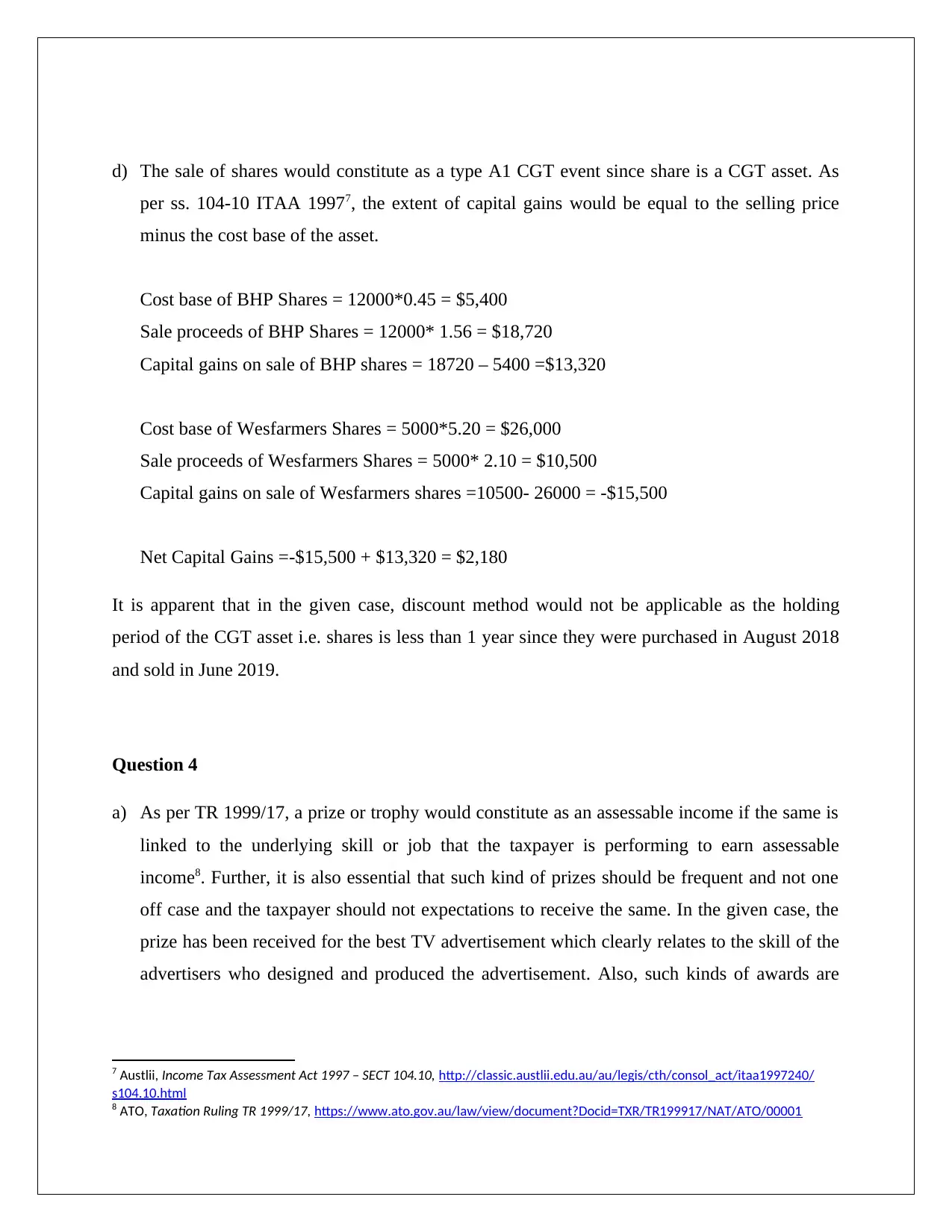
d) The sale of shares would constitute as a type A1 CGT event since share is a CGT asset. As
per ss. 104-10 ITAA 19977, the extent of capital gains would be equal to the selling price
minus the cost base of the asset.
Cost base of BHP Shares = 12000*0.45 = $5,400
Sale proceeds of BHP Shares = 12000* 1.56 = $18,720
Capital gains on sale of BHP shares = 18720 – 5400 =$13,320
Cost base of Wesfarmers Shares = 5000*5.20 = $26,000
Sale proceeds of Wesfarmers Shares = 5000* 2.10 = $10,500
Capital gains on sale of Wesfarmers shares =10500- 26000 = -$15,500
Net Capital Gains =-$15,500 + $13,320 = $2,180
It is apparent that in the given case, discount method would not be applicable as the holding
period of the CGT asset i.e. shares is less than 1 year since they were purchased in August 2018
and sold in June 2019.
Question 4
a) As per TR 1999/17, a prize or trophy would constitute as an assessable income if the same is
linked to the underlying skill or job that the taxpayer is performing to earn assessable
income8. Further, it is also essential that such kind of prizes should be frequent and not one
off case and the taxpayer should not expectations to receive the same. In the given case, the
prize has been received for the best TV advertisement which clearly relates to the skill of the
advertisers who designed and produced the advertisement. Also, such kinds of awards are
7 Austlii, Income Tax Assessment Act 1997 – SECT 104.10, http://classic.austlii.edu.au/au/legis/cth/consol_act/itaa1997240/
s104.10.html
8 ATO, Taxation Ruling TR 1999/17, https://www.ato.gov.au/law/view/document?Docid=TXR/TR199917/NAT/ATO/00001
per ss. 104-10 ITAA 19977, the extent of capital gains would be equal to the selling price
minus the cost base of the asset.
Cost base of BHP Shares = 12000*0.45 = $5,400
Sale proceeds of BHP Shares = 12000* 1.56 = $18,720
Capital gains on sale of BHP shares = 18720 – 5400 =$13,320
Cost base of Wesfarmers Shares = 5000*5.20 = $26,000
Sale proceeds of Wesfarmers Shares = 5000* 2.10 = $10,500
Capital gains on sale of Wesfarmers shares =10500- 26000 = -$15,500
Net Capital Gains =-$15,500 + $13,320 = $2,180
It is apparent that in the given case, discount method would not be applicable as the holding
period of the CGT asset i.e. shares is less than 1 year since they were purchased in August 2018
and sold in June 2019.
Question 4
a) As per TR 1999/17, a prize or trophy would constitute as an assessable income if the same is
linked to the underlying skill or job that the taxpayer is performing to earn assessable
income8. Further, it is also essential that such kind of prizes should be frequent and not one
off case and the taxpayer should not expectations to receive the same. In the given case, the
prize has been received for the best TV advertisement which clearly relates to the skill of the
advertisers who designed and produced the advertisement. Also, such kinds of awards are
7 Austlii, Income Tax Assessment Act 1997 – SECT 104.10, http://classic.austlii.edu.au/au/legis/cth/consol_act/itaa1997240/
s104.10.html
8 ATO, Taxation Ruling TR 1999/17, https://www.ato.gov.au/law/view/document?Docid=TXR/TR199917/NAT/ATO/00001
⊘ This is a preview!⊘
Do you want full access?
Subscribe today to unlock all pages.

Trusted by 1+ million students worldwide
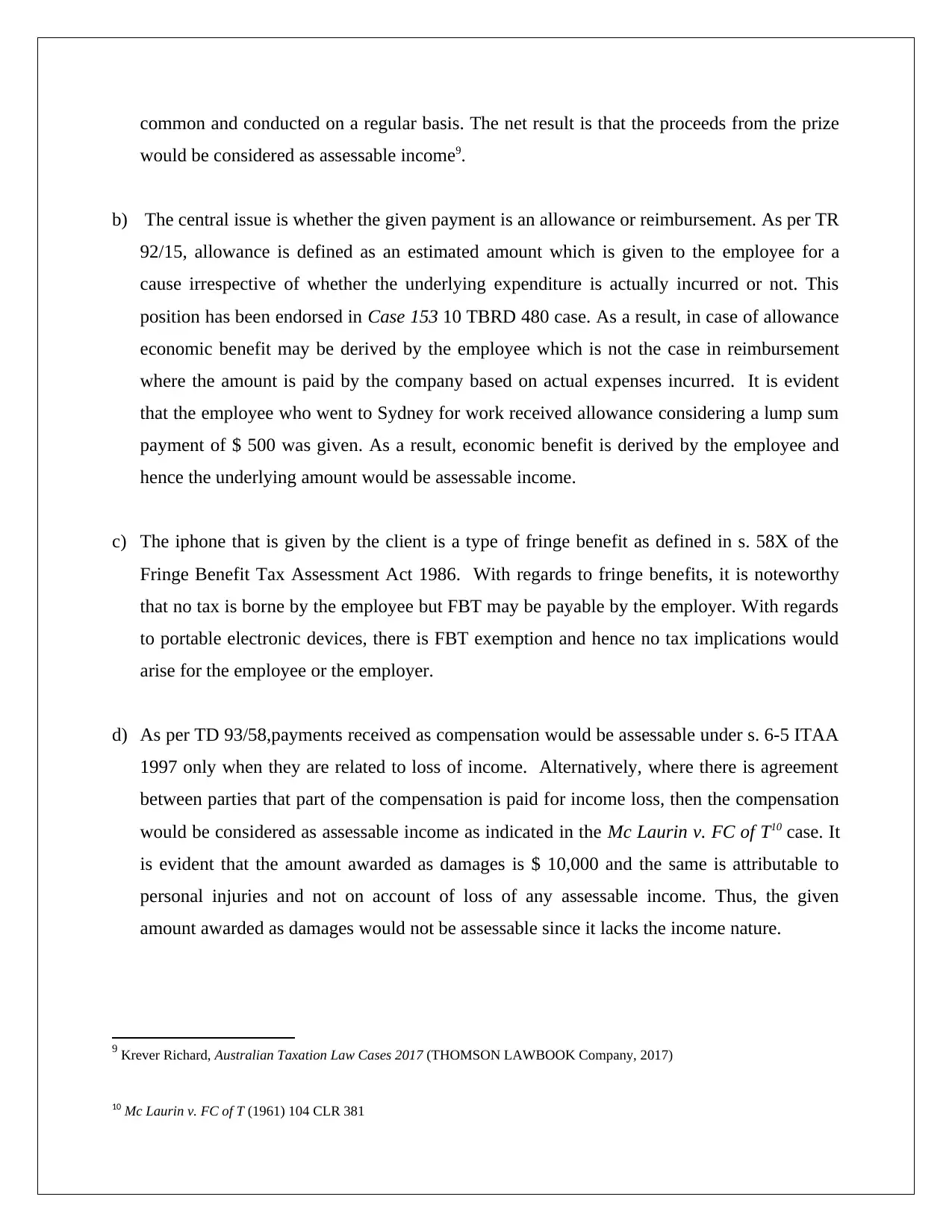
common and conducted on a regular basis. The net result is that the proceeds from the prize
would be considered as assessable income9.
b) The central issue is whether the given payment is an allowance or reimbursement. As per TR
92/15, allowance is defined as an estimated amount which is given to the employee for a
cause irrespective of whether the underlying expenditure is actually incurred or not. This
position has been endorsed in Case 153 10 TBRD 480 case. As a result, in case of allowance
economic benefit may be derived by the employee which is not the case in reimbursement
where the amount is paid by the company based on actual expenses incurred. It is evident
that the employee who went to Sydney for work received allowance considering a lump sum
payment of $ 500 was given. As a result, economic benefit is derived by the employee and
hence the underlying amount would be assessable income.
c) The iphone that is given by the client is a type of fringe benefit as defined in s. 58X of the
Fringe Benefit Tax Assessment Act 1986. With regards to fringe benefits, it is noteworthy
that no tax is borne by the employee but FBT may be payable by the employer. With regards
to portable electronic devices, there is FBT exemption and hence no tax implications would
arise for the employee or the employer.
d) As per TD 93/58,payments received as compensation would be assessable under s. 6-5 ITAA
1997 only when they are related to loss of income. Alternatively, where there is agreement
between parties that part of the compensation is paid for income loss, then the compensation
would be considered as assessable income as indicated in the Mc Laurin v. FC of T10 case. It
is evident that the amount awarded as damages is $ 10,000 and the same is attributable to
personal injuries and not on account of loss of any assessable income. Thus, the given
amount awarded as damages would not be assessable since it lacks the income nature.
9 Krever Richard, Australian Taxation Law Cases 2017 (THOMSON LAWBOOK Company, 2017)
10 Mc Laurin v. FC of T (1961) 104 CLR 381
would be considered as assessable income9.
b) The central issue is whether the given payment is an allowance or reimbursement. As per TR
92/15, allowance is defined as an estimated amount which is given to the employee for a
cause irrespective of whether the underlying expenditure is actually incurred or not. This
position has been endorsed in Case 153 10 TBRD 480 case. As a result, in case of allowance
economic benefit may be derived by the employee which is not the case in reimbursement
where the amount is paid by the company based on actual expenses incurred. It is evident
that the employee who went to Sydney for work received allowance considering a lump sum
payment of $ 500 was given. As a result, economic benefit is derived by the employee and
hence the underlying amount would be assessable income.
c) The iphone that is given by the client is a type of fringe benefit as defined in s. 58X of the
Fringe Benefit Tax Assessment Act 1986. With regards to fringe benefits, it is noteworthy
that no tax is borne by the employee but FBT may be payable by the employer. With regards
to portable electronic devices, there is FBT exemption and hence no tax implications would
arise for the employee or the employer.
d) As per TD 93/58,payments received as compensation would be assessable under s. 6-5 ITAA
1997 only when they are related to loss of income. Alternatively, where there is agreement
between parties that part of the compensation is paid for income loss, then the compensation
would be considered as assessable income as indicated in the Mc Laurin v. FC of T10 case. It
is evident that the amount awarded as damages is $ 10,000 and the same is attributable to
personal injuries and not on account of loss of any assessable income. Thus, the given
amount awarded as damages would not be assessable since it lacks the income nature.
9 Krever Richard, Australian Taxation Law Cases 2017 (THOMSON LAWBOOK Company, 2017)
10 Mc Laurin v. FC of T (1961) 104 CLR 381
Paraphrase This Document
Need a fresh take? Get an instant paraphrase of this document with our AI Paraphraser
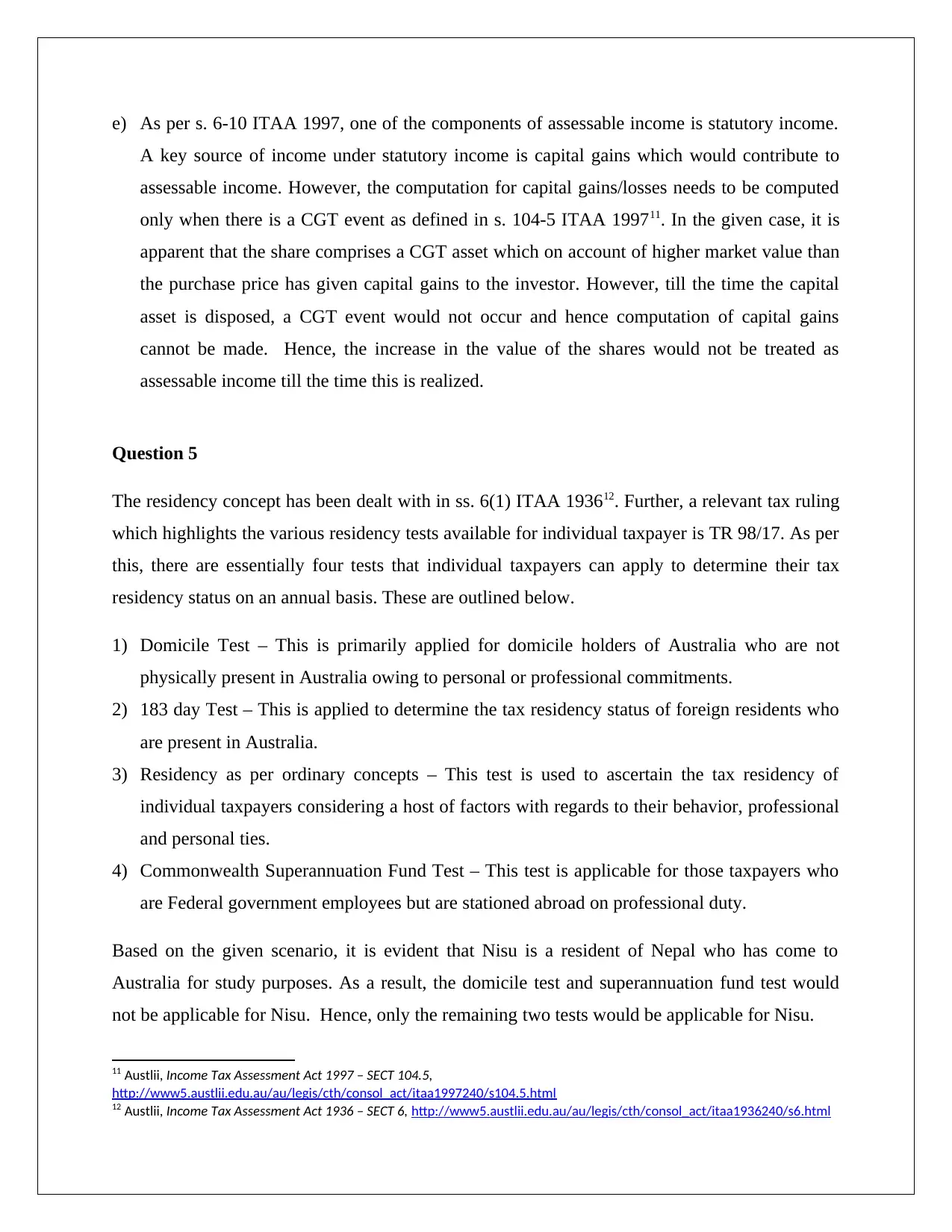
e) As per s. 6-10 ITAA 1997, one of the components of assessable income is statutory income.
A key source of income under statutory income is capital gains which would contribute to
assessable income. However, the computation for capital gains/losses needs to be computed
only when there is a CGT event as defined in s. 104-5 ITAA 199711. In the given case, it is
apparent that the share comprises a CGT asset which on account of higher market value than
the purchase price has given capital gains to the investor. However, till the time the capital
asset is disposed, a CGT event would not occur and hence computation of capital gains
cannot be made. Hence, the increase in the value of the shares would not be treated as
assessable income till the time this is realized.
Question 5
The residency concept has been dealt with in ss. 6(1) ITAA 193612. Further, a relevant tax ruling
which highlights the various residency tests available for individual taxpayer is TR 98/17. As per
this, there are essentially four tests that individual taxpayers can apply to determine their tax
residency status on an annual basis. These are outlined below.
1) Domicile Test – This is primarily applied for domicile holders of Australia who are not
physically present in Australia owing to personal or professional commitments.
2) 183 day Test – This is applied to determine the tax residency status of foreign residents who
are present in Australia.
3) Residency as per ordinary concepts – This test is used to ascertain the tax residency of
individual taxpayers considering a host of factors with regards to their behavior, professional
and personal ties.
4) Commonwealth Superannuation Fund Test – This test is applicable for those taxpayers who
are Federal government employees but are stationed abroad on professional duty.
Based on the given scenario, it is evident that Nisu is a resident of Nepal who has come to
Australia for study purposes. As a result, the domicile test and superannuation fund test would
not be applicable for Nisu. Hence, only the remaining two tests would be applicable for Nisu.
11 Austlii, Income Tax Assessment Act 1997 – SECT 104.5,
http://www5.austlii.edu.au/au/legis/cth/consol_act/itaa1997240/s104.5.html
12 Austlii, Income Tax Assessment Act 1936 – SECT 6, http://www5.austlii.edu.au/au/legis/cth/consol_act/itaa1936240/s6.html
A key source of income under statutory income is capital gains which would contribute to
assessable income. However, the computation for capital gains/losses needs to be computed
only when there is a CGT event as defined in s. 104-5 ITAA 199711. In the given case, it is
apparent that the share comprises a CGT asset which on account of higher market value than
the purchase price has given capital gains to the investor. However, till the time the capital
asset is disposed, a CGT event would not occur and hence computation of capital gains
cannot be made. Hence, the increase in the value of the shares would not be treated as
assessable income till the time this is realized.
Question 5
The residency concept has been dealt with in ss. 6(1) ITAA 193612. Further, a relevant tax ruling
which highlights the various residency tests available for individual taxpayer is TR 98/17. As per
this, there are essentially four tests that individual taxpayers can apply to determine their tax
residency status on an annual basis. These are outlined below.
1) Domicile Test – This is primarily applied for domicile holders of Australia who are not
physically present in Australia owing to personal or professional commitments.
2) 183 day Test – This is applied to determine the tax residency status of foreign residents who
are present in Australia.
3) Residency as per ordinary concepts – This test is used to ascertain the tax residency of
individual taxpayers considering a host of factors with regards to their behavior, professional
and personal ties.
4) Commonwealth Superannuation Fund Test – This test is applicable for those taxpayers who
are Federal government employees but are stationed abroad on professional duty.
Based on the given scenario, it is evident that Nisu is a resident of Nepal who has come to
Australia for study purposes. As a result, the domicile test and superannuation fund test would
not be applicable for Nisu. Hence, only the remaining two tests would be applicable for Nisu.
11 Austlii, Income Tax Assessment Act 1997 – SECT 104.5,
http://www5.austlii.edu.au/au/legis/cth/consol_act/itaa1997240/s104.5.html
12 Austlii, Income Tax Assessment Act 1936 – SECT 6, http://www5.austlii.edu.au/au/legis/cth/consol_act/itaa1936240/s6.html
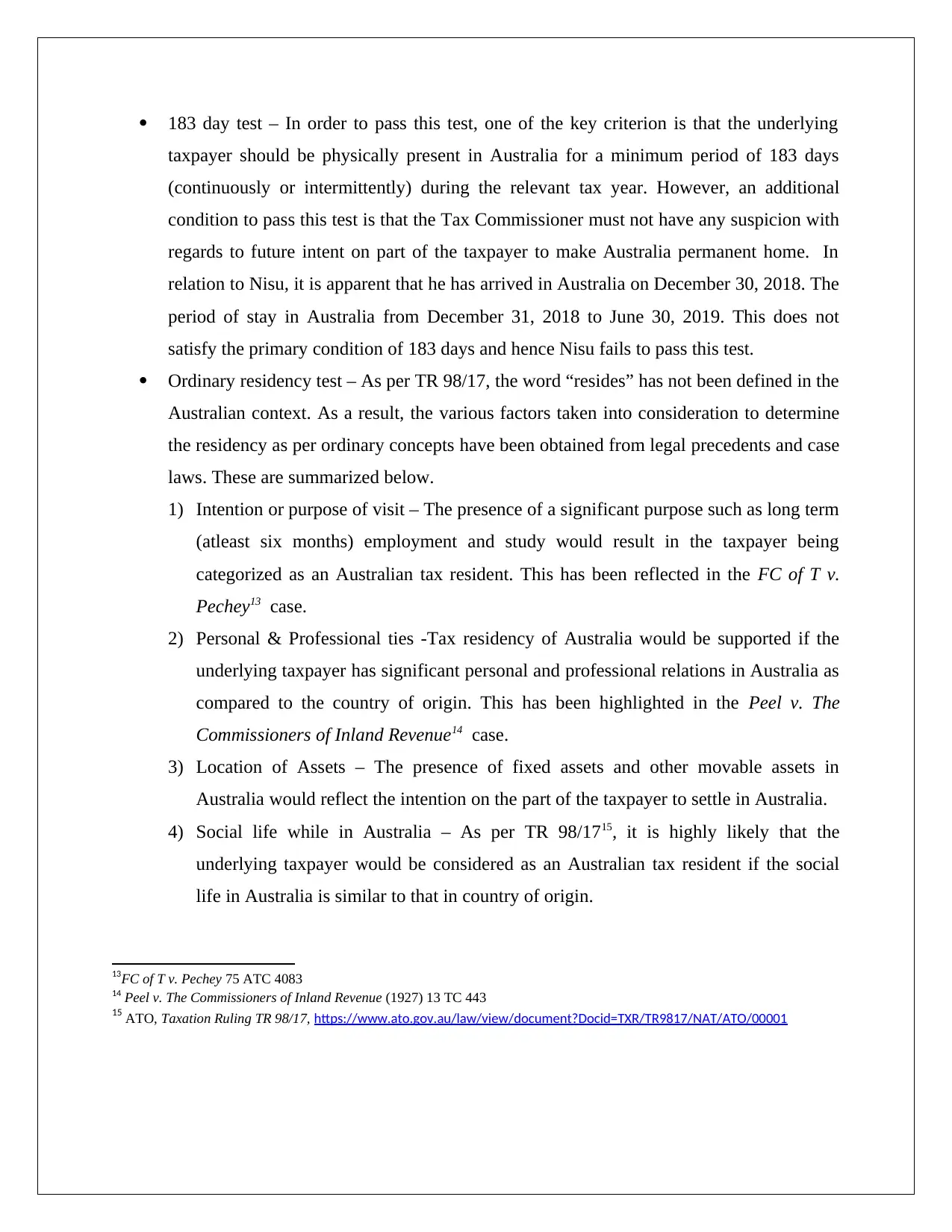
183 day test – In order to pass this test, one of the key criterion is that the underlying
taxpayer should be physically present in Australia for a minimum period of 183 days
(continuously or intermittently) during the relevant tax year. However, an additional
condition to pass this test is that the Tax Commissioner must not have any suspicion with
regards to future intent on part of the taxpayer to make Australia permanent home. In
relation to Nisu, it is apparent that he has arrived in Australia on December 30, 2018. The
period of stay in Australia from December 31, 2018 to June 30, 2019. This does not
satisfy the primary condition of 183 days and hence Nisu fails to pass this test.
Ordinary residency test – As per TR 98/17, the word “resides” has not been defined in the
Australian context. As a result, the various factors taken into consideration to determine
the residency as per ordinary concepts have been obtained from legal precedents and case
laws. These are summarized below.
1) Intention or purpose of visit – The presence of a significant purpose such as long term
(atleast six months) employment and study would result in the taxpayer being
categorized as an Australian tax resident. This has been reflected in the FC of T v.
Pechey13 case.
2) Personal & Professional ties -Tax residency of Australia would be supported if the
underlying taxpayer has significant personal and professional relations in Australia as
compared to the country of origin. This has been highlighted in the Peel v. The
Commissioners of Inland Revenue14 case.
3) Location of Assets – The presence of fixed assets and other movable assets in
Australia would reflect the intention on the part of the taxpayer to settle in Australia.
4) Social life while in Australia – As per TR 98/1715, it is highly likely that the
underlying taxpayer would be considered as an Australian tax resident if the social
life in Australia is similar to that in country of origin.
13FC of T v. Pechey 75 ATC 4083
14 Peel v. The Commissioners of Inland Revenue (1927) 13 TC 443
15 ATO, Taxation Ruling TR 98/17, https://www.ato.gov.au/law/view/document?Docid=TXR/TR9817/NAT/ATO/00001
taxpayer should be physically present in Australia for a minimum period of 183 days
(continuously or intermittently) during the relevant tax year. However, an additional
condition to pass this test is that the Tax Commissioner must not have any suspicion with
regards to future intent on part of the taxpayer to make Australia permanent home. In
relation to Nisu, it is apparent that he has arrived in Australia on December 30, 2018. The
period of stay in Australia from December 31, 2018 to June 30, 2019. This does not
satisfy the primary condition of 183 days and hence Nisu fails to pass this test.
Ordinary residency test – As per TR 98/17, the word “resides” has not been defined in the
Australian context. As a result, the various factors taken into consideration to determine
the residency as per ordinary concepts have been obtained from legal precedents and case
laws. These are summarized below.
1) Intention or purpose of visit – The presence of a significant purpose such as long term
(atleast six months) employment and study would result in the taxpayer being
categorized as an Australian tax resident. This has been reflected in the FC of T v.
Pechey13 case.
2) Personal & Professional ties -Tax residency of Australia would be supported if the
underlying taxpayer has significant personal and professional relations in Australia as
compared to the country of origin. This has been highlighted in the Peel v. The
Commissioners of Inland Revenue14 case.
3) Location of Assets – The presence of fixed assets and other movable assets in
Australia would reflect the intention on the part of the taxpayer to settle in Australia.
4) Social life while in Australia – As per TR 98/1715, it is highly likely that the
underlying taxpayer would be considered as an Australian tax resident if the social
life in Australia is similar to that in country of origin.
13FC of T v. Pechey 75 ATC 4083
14 Peel v. The Commissioners of Inland Revenue (1927) 13 TC 443
15 ATO, Taxation Ruling TR 98/17, https://www.ato.gov.au/law/view/document?Docid=TXR/TR9817/NAT/ATO/00001
⊘ This is a preview!⊘
Do you want full access?
Subscribe today to unlock all pages.

Trusted by 1+ million students worldwide
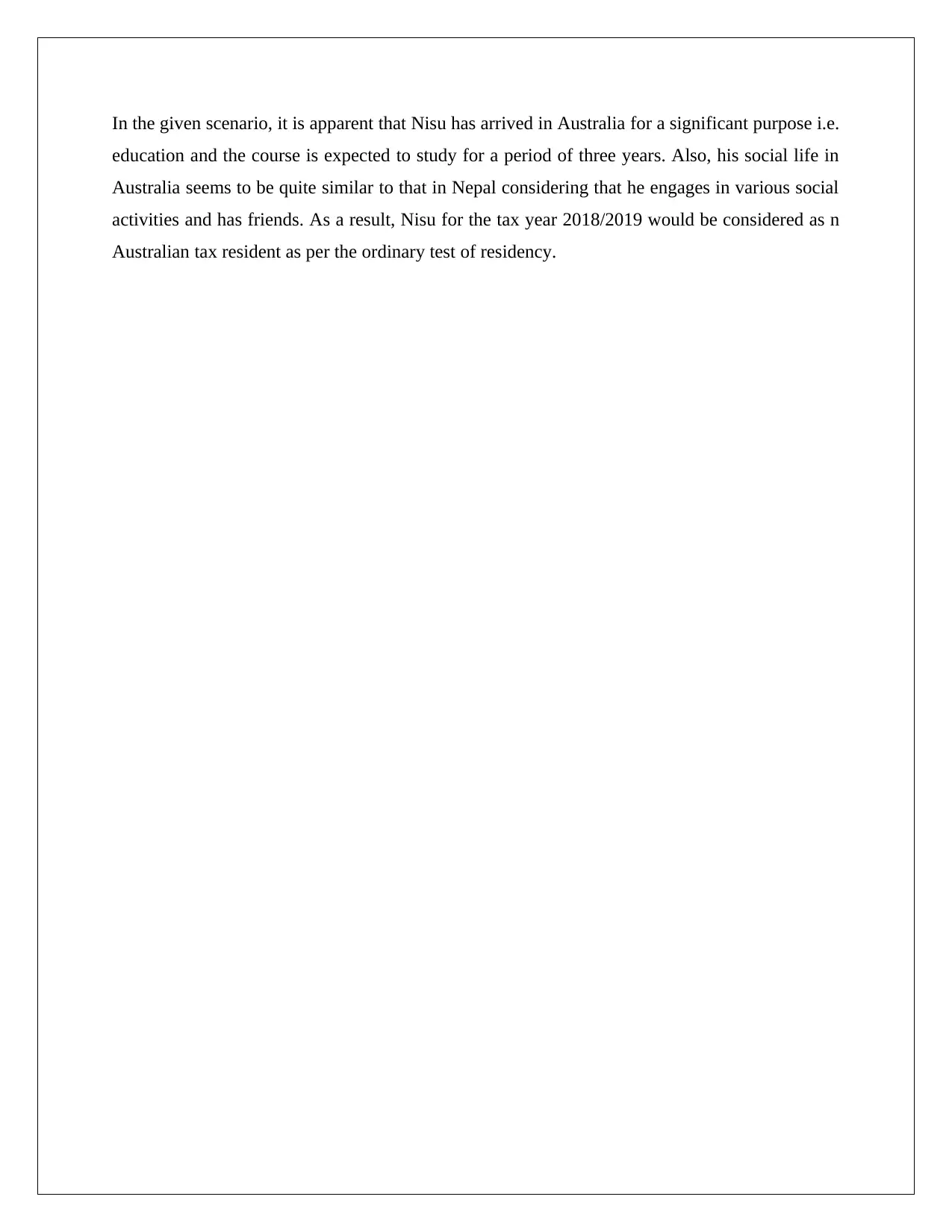
In the given scenario, it is apparent that Nisu has arrived in Australia for a significant purpose i.e.
education and the course is expected to study for a period of three years. Also, his social life in
Australia seems to be quite similar to that in Nepal considering that he engages in various social
activities and has friends. As a result, Nisu for the tax year 2018/2019 would be considered as n
Australian tax resident as per the ordinary test of residency.
education and the course is expected to study for a period of three years. Also, his social life in
Australia seems to be quite similar to that in Nepal considering that he engages in various social
activities and has friends. As a result, Nisu for the tax year 2018/2019 would be considered as n
Australian tax resident as per the ordinary test of residency.
Paraphrase This Document
Need a fresh take? Get an instant paraphrase of this document with our AI Paraphraser
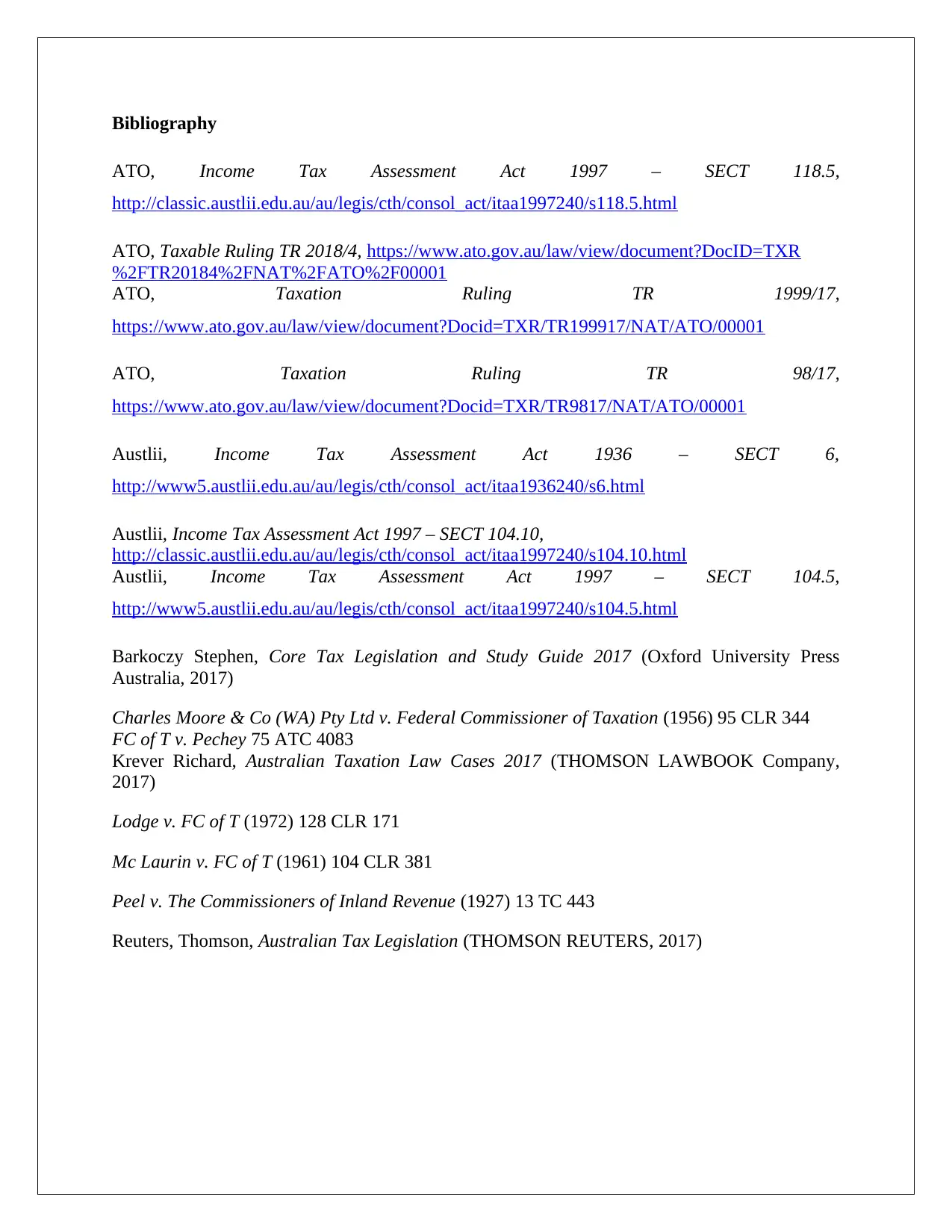
Bibliography
ATO, Income Tax Assessment Act 1997 – SECT 118.5,
http://classic.austlii.edu.au/au/legis/cth/consol_act/itaa1997240/s118.5.html
ATO, Taxable Ruling TR 2018/4, https://www.ato.gov.au/law/view/document?DocID=TXR
%2FTR20184%2FNAT%2FATO%2F00001
ATO, Taxation Ruling TR 1999/17,
https://www.ato.gov.au/law/view/document?Docid=TXR/TR199917/NAT/ATO/00001
ATO, Taxation Ruling TR 98/17,
https://www.ato.gov.au/law/view/document?Docid=TXR/TR9817/NAT/ATO/00001
Austlii, Income Tax Assessment Act 1936 – SECT 6,
http://www5.austlii.edu.au/au/legis/cth/consol_act/itaa1936240/s6.html
Austlii, Income Tax Assessment Act 1997 – SECT 104.10,
http://classic.austlii.edu.au/au/legis/cth/consol_act/itaa1997240/s104.10.html
Austlii, Income Tax Assessment Act 1997 – SECT 104.5,
http://www5.austlii.edu.au/au/legis/cth/consol_act/itaa1997240/s104.5.html
Barkoczy Stephen, Core Tax Legislation and Study Guide 2017 (Oxford University Press
Australia, 2017)
Charles Moore & Co (WA) Pty Ltd v. Federal Commissioner of Taxation (1956) 95 CLR 344
FC of T v. Pechey 75 ATC 4083
Krever Richard, Australian Taxation Law Cases 2017 (THOMSON LAWBOOK Company,
2017)
Lodge v. FC of T (1972) 128 CLR 171
Mc Laurin v. FC of T (1961) 104 CLR 381
Peel v. The Commissioners of Inland Revenue (1927) 13 TC 443
Reuters, Thomson, Australian Tax Legislation (THOMSON REUTERS, 2017)
ATO, Income Tax Assessment Act 1997 – SECT 118.5,
http://classic.austlii.edu.au/au/legis/cth/consol_act/itaa1997240/s118.5.html
ATO, Taxable Ruling TR 2018/4, https://www.ato.gov.au/law/view/document?DocID=TXR
%2FTR20184%2FNAT%2FATO%2F00001
ATO, Taxation Ruling TR 1999/17,
https://www.ato.gov.au/law/view/document?Docid=TXR/TR199917/NAT/ATO/00001
ATO, Taxation Ruling TR 98/17,
https://www.ato.gov.au/law/view/document?Docid=TXR/TR9817/NAT/ATO/00001
Austlii, Income Tax Assessment Act 1936 – SECT 6,
http://www5.austlii.edu.au/au/legis/cth/consol_act/itaa1936240/s6.html
Austlii, Income Tax Assessment Act 1997 – SECT 104.10,
http://classic.austlii.edu.au/au/legis/cth/consol_act/itaa1997240/s104.10.html
Austlii, Income Tax Assessment Act 1997 – SECT 104.5,
http://www5.austlii.edu.au/au/legis/cth/consol_act/itaa1997240/s104.5.html
Barkoczy Stephen, Core Tax Legislation and Study Guide 2017 (Oxford University Press
Australia, 2017)
Charles Moore & Co (WA) Pty Ltd v. Federal Commissioner of Taxation (1956) 95 CLR 344
FC of T v. Pechey 75 ATC 4083
Krever Richard, Australian Taxation Law Cases 2017 (THOMSON LAWBOOK Company,
2017)
Lodge v. FC of T (1972) 128 CLR 171
Mc Laurin v. FC of T (1961) 104 CLR 381
Peel v. The Commissioners of Inland Revenue (1927) 13 TC 443
Reuters, Thomson, Australian Tax Legislation (THOMSON REUTERS, 2017)
1 out of 11
Related Documents
Your All-in-One AI-Powered Toolkit for Academic Success.
+13062052269
info@desklib.com
Available 24*7 on WhatsApp / Email
![[object Object]](/_next/static/media/star-bottom.7253800d.svg)
Unlock your academic potential
© 2024 | Zucol Services PVT LTD | All rights reserved.





